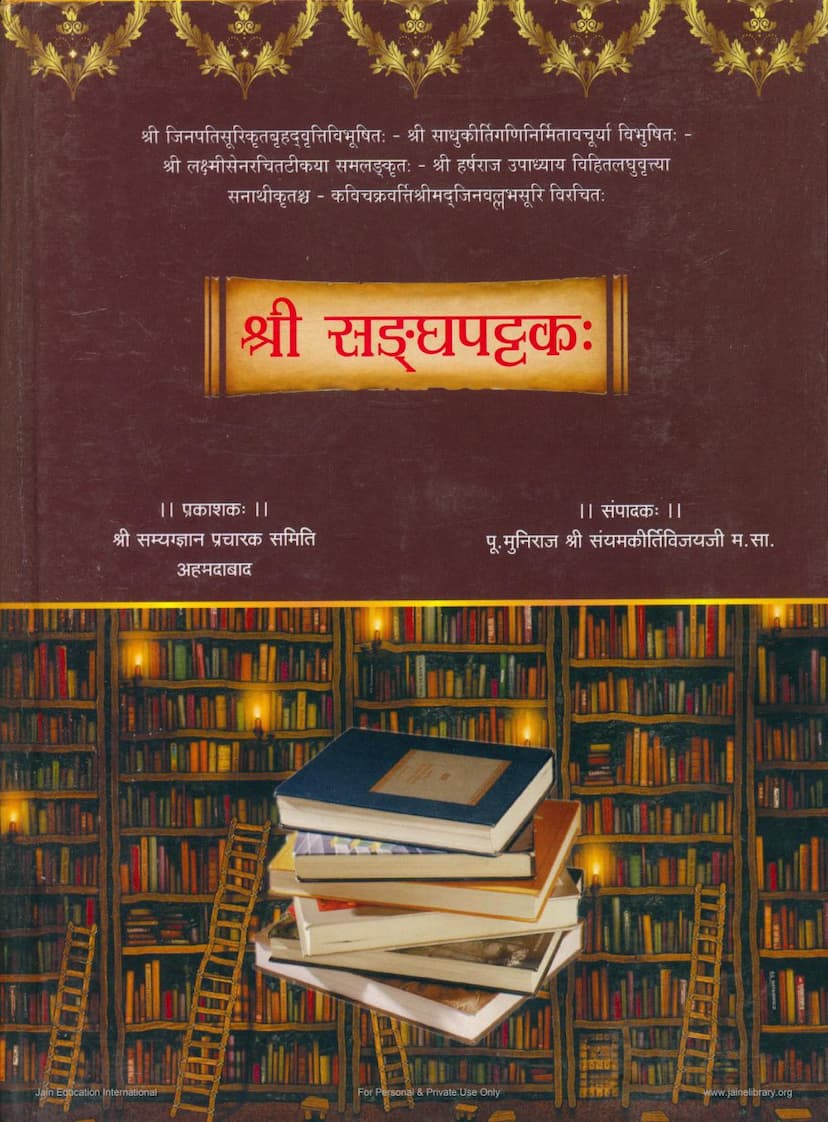Sanghpattak
Added to library: September 2, 2025

Summary
The provided text is the Jain text titled "Sanghpattak" by author Sanyamkirtivijay, published by Samyag Gyan Pracharak Mandal. The catalog link is also provided. The document includes several pages of the text with its various commentaries and introductions, along with details about the publication and acknowledgments.
Here's a comprehensive summary in English, extracting key information from the provided pages:
Book Title: Shree Sanghpattak
Author of the Primary Work: Kavi Chakravarti Shree Jinavallabh Suri
Publisher: Shree Samyag Gyan Pracharak Mandal, Ahmedabad
Editor: Pujya Muniraj Shree Sanyamkirtivijayji M.S.
Overall Purpose:
The Sanghpattak is a crucial Jain text primarily aimed at refuting and condemning the practice of 'Chaitya-vas' (residing within Jain temples or monasteries by ascetics). It advocates for the 'Suvihit' (well-conducted) tradition and highlights the correct conduct and principles of Jain ascetics, contrasting them with the deviations introduced by Chaitya-vasis.
Key Commentaries/Recensions Mentioned:
The book is enriched with several layers of commentaries, indicating its significant importance and the need for detailed explanation:
- Brihad-vritti by Shree Jinpatisuri: Described as a major commentary, akin to a "Maha-bhashya" (great commentary), demonstrating profound scholarly depth and logical argumentation to support the original text.
- Avachuri by Shree Sadhukirti Ganin: This commentary is also highly valued.
- Tika by Shree Lakshmisena: Mentioned as a commentary providing clear explanations.
- Laghu-vritti by Upadhyay Shree Harshraj: A concise commentary.
Historical Context and Content:
The text delves into a significant historical period in Jainism, highlighting a period of decline characterized by the rise of 'Chaitya-vas.'
- The Problem of Chaitya-vas: The introduction explains that after Lord Mahavir's Nirvana, around 850 years later, 'Chaitya-vas' was established, and its influence grew significantly by 1000 years. This practice led to a departure from the original, austere traditions of Jain ascetics (Nigranthas) who lived in forests or borrowed dwellings and avoided material possessions and comforts.
- Rejection of Chaitya-vas: The Sanghpattak is presented as a definitive independent text that criticizes Chaitya-vas. The text argues that Chaitya-vasis began to reside in temples, deviated from scriptural conduct, accumulated wealth, and introduced practices contrary to the core Jain principles. This led to a fragmentation of the original monastic order, with many branches (up to 84) emerging, often in conflict.
- The Author's Contribution: Shree Jinavallabh Suri, the author of the Sanghpattak, is lauded for his unique poetic prowess and logical arguments in countering the Chaitya-vasis. He is credited with exposing their deviations from scriptures, their malice towards well-conducted monks, and encouraging those who adhered to the correct path.
- Inscriptions: The Sanghpattak, consisting of 40 verses, was inscribed on stone pillars at the entrance of a 'Vidhi-Chaitya' (temple following correct rituals) built in Chittor by the efforts of Shree Jinavallabh Suri, after he enlightened the main lay followers there.
- Lineage of Scholars: The text traces a scholarly lineage, mentioning prominent figures like Shree Haribhadra Suri, who refuted Chaitya-vas in his commentary on the Mahanishith Sutra. It highlights the contributions of Shree Jinishwar Suri, Shree Abhaydev Suri, Shree Jinapati Suri, and others in establishing the Suvihit tradition and challenging Chaitya-vas.
- Critique of Deviations: The text meticulously details various forms of 'Avidha' (improper conduct) that crept in, including:
- Oudheshika bhojan (food prepared with the intention of offering to monks).
- Residence in temples (Chaitya-vas).
- Resentment towards dwelling places (Vasatyakshama).
- Acceptance of wealth and possessions.
- Improper seating arrangements (Apratikshita-aasana).
- Attachment to sinful activities (Savadyacharana).
- Disregard for scriptures (Shruta-patha-avajna).
- Envy and hatred towards virtuous monks (Guni-dvesha-dhi).
- The Purpose of the Text: The Sanghpattak serves as a "chamuk" (whip-like) critique to awaken people, especially the monks, from their complacency and adherence to these deviations. It aims to instill a love for the true path and lead to liberation.
- Modern Relevance: The editorial notes express concern that despite the historical refutation of Chaitya-vas, similar laxities have resurfaced, with current monks residing in 'Matha' (monasteries) attached to temples, often misinterpreting it as their original tradition. The publication of this text aims to clarify the truth for such individuals.
- Word Ambiguities: The introduction also addresses and clarifies common misunderstandings regarding terms like 'Sangh' (originally referring to the four-fold community, now often limited to lay followers) and 'Deravasi' (originally meaning temple dwellers, now used by those who follow rituals associated with temples).
- Compilation Effort: The current edition is a compilation of previously published works (Brihad-vritti, Avachuri, and two Laghu-vrittis) due to the deteriorating condition of the original books.
Key Themes:
- Adherence to Scriptural Principles: The central theme is the unwavering importance of following the scriptures and the conduct prescribed by the Tirthankaras.
- Critique of Deviation: The text strongly condemns practices that deviate from these principles, especially 'Chaitya-vas'.
- The Role of Virtuous Ascetics: It celebrates the role of ascetic gurus who uphold the true path, often at great personal risk.
- Historical Significance: The Sanghpattak provides valuable historical insights into the evolution and challenges within the Jain tradition.
- Spiritual Purity: The ultimate aim is to guide individuals towards spiritual purity and liberation by adhering to the correct path.
Publication Details:
- Printing Arrangement: Sanmarg Prakashan, Ahmedabad
- Typography: Akhilesh Mishra, Virati Graphics, Ahmedabad
- Number of Copies: 400
- Edition: First Edition, V.S. 2070
- Price: ₹ 250.00
The text also includes acknowledgments and dedications to various spiritual gurus and patrons, emphasizing the reverence and respect within the tradition. The editor, Muni Shree Sanyamkirtivijayji, expresses gratitude to those who inspired and supported the re-editing and publication of this important work.